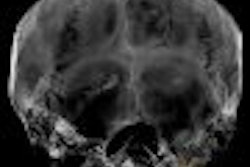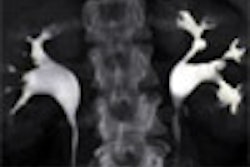NEW ORLEANS - What's good for the liver is good for the lung, according to results from a multicenter pilot trial of radiofrequency ablation (RFA). Italian investigators successfully used RFA to treat non-small cell lung cancer (NSCLC) in patients who were not candidates for surgery, external beam radiotherapy, and/or chemotherapy.
In a presentation Saturday at the Society for Interventional Radiology (SIR) meeting, Dr. Riccardo Lencioni said RFA achieved 91.5% cancer-specific survival at two years among patients with NSCLC, and in patients with colorectal cancer metastases to the lung the two-year cancer-free survival was 72%.
Lencioni, who is an associate professor of radiology at the University of Pisa in Italy, updated the results of this study, which he also presented at the 2004 RSNA meeting in Chicago. He said complete ablation of the tumor was achieved in 173 of 186 lesions for a primary efficacy rate of 93%.
"Surgery is still the first option for patients with early-stage lung cancer, but for patients who are not candidates for surgery or for standard radiation therapy, RFA should be considered an option," he stated.
The study, called Radiofrequency Ablation of Pulmonary Tumors Response Evaluation (RAPTURE) and funded by RITA Medical Systems of Mountain View, CA, was "really designed as a pilot. We did not expect to see these results in the lung. These outcomes are much better than I anticipated," Lencioni said.
The study enrolled 33 NSCLC patients, 53 colorectal cancer patients, and 20 patients with metastasis from other primary malignancies. Thirty-six patients were women and the mean age of patients was 65. There were a total of 186 malignant lung tumors treated, and all were 3.5 cm or smaller.
CT-guided RFA was performed under conscious sedation using 150-200-watt generators and expandable multitined electrodes (Starburst XL). Follow-up included CT exams at one and three months and three months thereafter. The mean follow-up was nine months.
RFA was generally well-tolerated and the most common procedure-related side effect was pneumothorax (n = 27). However, "the pneumothorax rate was no greater than the rate seen with biopsy. Pneumothorax was apparent immediately after withdrawing the needle and responded to chest tube," Lencioni said.
There were no procedure-related deaths. Four patients had pleural effusion requiring treatment, two had pneumonias, and one had atelectasis.
In general, the NSCLC patients in the study all had demonstrable effects of a lifetime of smoking, so it was not surprising that the overall two-year survival among these patients was just 49.3%, he explained.
"These were not cancer deaths," he told AuntMinnie.com. "These were deaths due to stroke, heart attack, heart failure, (chronic obstructive pulmonary disorder) -- the list goes on, but not cancer." The overall survival rate for the colorectal cancer patients -- who often were in better shape than the NSCLC patients -- was 62%, but in these patients ... a significant number of deaths were due to cancer."
While these results are promising, Lencioni said that a randomized controlled trial was needed to confirm the role of RFA in the treatment of malignant lung tumors.
By Peggy PeckAuntMinnie.com contributing writer
April 4, 2005
Related Reading
RF ablation curbs colorectal cancer liver metastasis, March 30, 2005
RF ablation gains ground as lung cancer option, January 14, 2005
RFA shows high success rate in lung tumor ablation, December 2, 2003
Copyright © 2005 AuntMinnie.com



















